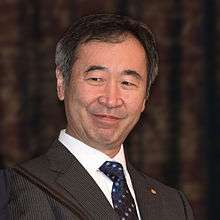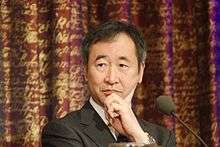Takaaki Kajita
Takaaki Kajita (梶田 隆章, Kajita Takaaki, Japanese pronunciation: [kadʑita takaːki]; born 9 March 1959) is a Japanese physicist, known for neutrino experiments at the Kamiokande and its successor, Super-Kamiokande. In 2015, he was awarded the Nobel Prize in Physics jointly with Canadian physicist Arthur B. McDonald.
Takaaki Kajita | |
|---|---|
 Takaaki Kajita, Nobel Laureate in physics in Stockholm December 2015 | |
| Born | 9 March 1959 |
| Nationality | Japanese |
| Education | Saitama Prefectural Kawagoe High School |
| Alma mater | Saitama University (B.S.) University of Tokyo (M.S., Ph.D.) |
| Spouse(s) | Michiko |
| Awards | Asahi Prize (1988) Bruno Rossi Prize (1989) Nishina Memorial Prize (1999) Panofsky Prize (2002) Japan Academy Prize (2012) Nobel Prize in Physics (2015) Fundamental Physics Prize (2016) |
| Scientific career | |
| Institutions | Kavli Institute for the Physics and Mathematics of the Universe, University of Tokyo |
| Doctoral advisor | Masatoshi Koshiba |
| Other academic advisors | Yoji Totsuka |
Early life and education
Kajita was born in 1959 in Higashimatsuyama, Saitama, Japan.[1] He liked studying thought rather than memorizing, especially with interest in physics, organism, world history, Japanese history, and earth science in high school. He studied physics at the Saitama University and graduated in 1981. He received his doctorate in 1986 at the University of Tokyo.[2] In UTokyo, he joined Masatoshi Koshiba's laboratory because they were "somehow interested".
Career and research
Since 1988 Kajita has been at the Institute for Cosmic Radiation Research, University of Tokyo, where he became an assistant professor in 1992 and professor in 1999.[3]
He became director of the Center for Cosmic Neutrinos at the Institute for Cosmic Ray Research (ICRR) in 1999. As of 2017, he is a Principal Investigator at the Institute for the Physics and Mathematics of the Universe in Tokyo, and Director of ICRR.[4]
In 1998, Kajita's team at the Super-Kamiokande found that when cosmic rays hit the Earth's atmosphere, the resulting neutrinos switched between two flavours before they reached the detector under Mt. Kamioka.[2][5] This discovery helped prove the existence of neutrino oscillation and that neutrinos have mass. In 2015, Kajita shared the Nobel Prize in Physics with Canadian physicist Arthur McDonald, whose Sudbury Neutrino Observatory discovered similar results.[5] Kajita's and McDonald's work solved the longstanding Solar neutrino problem, which was a major discrepancy between the predicted and measured Solar neutrino fluxes, and indicated that the Standard Model, which required neutrinos to be massless, had weaknesses.[5] In a news conference at the University of Tokyo, shortly after the Nobel announcement, Kajita said, "I want to thank the neutrinos, of course. And since neutrinos are created by cosmic rays, I want to thank them, too."[6]
One of the first people Kajita called after receiving the Nobel Prize was 2002 Nobel physics laureate Masatoshi Koshiba, his former mentor and a fellow neutrino researcher.[2]
Kajita is currently the principal investigator of another ICRR project located at the Kamioka Observatory, the KAGRA gravitational wave detector.[7]
Recognition

Awards
- 1987 – Asahi Prize as part of Kamiokande (Representative – Masatoshi Koshiba)[8]
- 1989 – Bruno Rossi Prize along with the other members of the Kamiokande collaboration[9]
- 1998 – Asahi Prize as part of Super-Kamiokande (Representative – Yoji Totsuka)[10]
- 1999 – Nishina Memorial Prize[11]
- 2002 – Panofsky Prize for compelling experimental evidence for neutrino oscillations using atmospheric neutrinos[12]
- 2010 – Yoji Totsuka Award[13]
- 2012 – Japan Academy Prize for "Discovery of Atmospheric Neutrino Oscillations"[14][15]
- 2013 – Julius Wess Award for his "significant role in the Discovery of Atmospheric Neutrino Oscillations with the Super-KAMIOKANDE Experiment."[16]
- 2015 – Nobel Prize in Physics jointly with Arthur B. McDonald for the discovery of neutrino oscillations, which shows that neutrinos have mass.[17]
- 2016 – Fundamental Physics Prize[18]
Honors
- 2015 – Order of Culture, Person of Cultural Merit
- 2016 – Doctorate in Science (DSc), Aligarh Muslim University, India[19]
- 2016 – Honoris Causa Degree, Higher University of San Andrés, La Paz, Bolivia.[20]
- 2017 – Honoris Causa Degree in Physics, University of Naples Federico II[21]
- 2017 – Honoris Causa Degree in Physics, University of Bern[22]
See also
References
- "Takaaki Kajita - Facts". Nobel Foundation. 6 October 2015. Retrieved 6 October 2015.
- "Japan's Takaaki Kajita shares Nobel in physics". Japan Times. 6 October 2015. Retrieved 7 October 2015.
- "2015 Nobel Prize in Physics: Canadian Arthur B. McDonald shares win with Japan's Takaaki Kajita". CBC News. 6 October 2015. Retrieved 6 October 2015.
- "About ICRR". Institute for Cosmic Ray Research, University of Tokyo.
- Randerson, James and Ian Sample (6 October 2015). "Kajita and McDonald win Nobel physics prize for work on neutrinos". The Guardian. Retrieved 6 October 2015.
- Overbye, Dennis (6 October 2015). "Takaaki Kajita and Arthur McDonald Share Nobel in Physics for Work on Neutrinos". New York Times. Retrieved 6 October 2015.
- "Professor Kajita won the novel prize in physics !!" (Press release). KAGRA collaboration. 7 October 2015.
Professor Kajita, who is the PI of KAGRA, won the Nobel prize in physics !!
- "Recipients of the Asahi Prize". Asahi Shimbun. Retrieved 12 August 2016.
- "HEAD AAS Rossi Prize Winners". Home High Energy Astrophysics Division. Retrieved 12 August 2016.
- "Recipients of the Asahi Prize". Asahi Shimbun. Retrieved 12 August 2016.
- "Recipients of Nishina Memorial Prizes". Nishina Memorial Foundation. Retrieved 12 August 2016.
- "2002 W.K.H. Panofsky Prize in Experimental Particle Physics Recipient". American Physical Society. Retrieved 12 August 2016.
- "第1回「戸塚洋二賞」選考結果". Heisei Foundation for Basic Science. 24 February 2012. Archived from the original on 6 March 2016. Retrieved 17 November 2015.(in Japanese)
- "The Imperial Prize, Japan Academy Prize, Duke of Edinburgh Prize Recipients". Japan Academy. 4 June 2012. Retrieved 12 August 2016.
- "Japan Academy Prize to – Takaaki Kajita" (PDF). Japan Academy. 4 June 2012. Retrieved 12 August 2016.
- "Julius Wess Award to Takaaki Kajita". Kavli Institute for the Physics and Mathematics of the Universe. 27 November 2013. Retrieved 17 November 2015.
- "The Nobel Prize in Physics 2015".. Nobelprize.org. Nobel Media AB 2014. Web. 6 October 2015.
- "Breakthrough Prize Awarded $22 Million In Science Prizes" (Press release). San Francisco: Fundamental Physics Prize. 8 November 2015.
- Azeem, Ahmad. "Nobel Laureate Takaaki Kajita conferred DSc at AMU's 64th convocation". India Today. Retrieved 1 November 2016.
- "Kajita: Emociones de la ciencia esperan a los jóvenes bolivianos". Página Siete. 3 May 2016. Retrieved 10 October 2019.
- "Federico II, laurea honors causa al Premio Nobel Takaaki Kajita". Il Mattino. 30 January 2017. Retrieved 10 October 2019.
- "Honors". University of Bern. 2017. Archived from the original on 8 January 2018. Retrieved 10 October 2019.
External links
- Official website
- Panofsky Preis
- Verleihung des Julius Wess Preises 2013 mit Vortrag von Kajita
- KAGRA, the Latest "Gravitational Wave Telescope" Project, Commences via JST Science News 2012
- Takaaki Kajita Quotes With Pictures
- Interview with Takaaki Kajita, on Editage Insights: In my days, nobody felt rushed just because research was making slow progress
